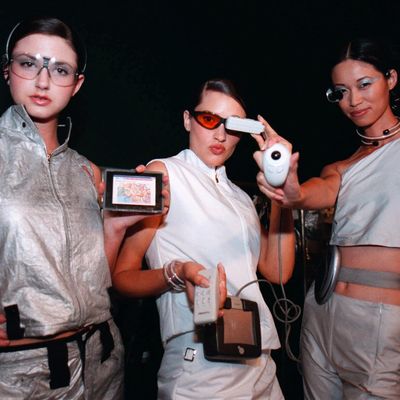
There’s a new theme every day on It’s Vintage. Read more articles on today’s topic: the History of Wearable Tech.
Given the predictions that we’d go out like the Mayans when wearable tech first took off, it’s a miracle we’ve all survived to reap the benefits of the present crop of wearable devices, from smartwatches to fitness trackers. We’ve come a long way from computer helmets with antennae, but the transition has had its fair share of hilariously melodramatic news coverage. Below, some ripped-from-the-headlines moments from the last few decades that almost read like satire.
When Pulsar came out with the calculator watch — the “Time Computer” — at the end of 1975, the Times declared the device “the technologically chic way to tell time” and likened its miraculously glowing numbers to a television screen. One source quoted thought they may presage the fall of American culture, felling us all “like the Mayans.”
Some see the digital watch as yet another sad and alienating symbol of the culture, a micro-electronic monster printing out “isolated minutes” that have no meaning without a face, without a tick to mark the passing of a human lifetime.
Next time you leave your headphones at home, just be glad you don’t have to cart around a 30-pound “personal stereo” to make your commute bearable. First there were boom boxes, or “blaring behemoths,” as the Times called them, then Sony came out with the Walkman in late 1979 at a pricey $200. The portable-music craze soon exploded, as prices dropped and other brands followed suit, prompting the Times to report on the “headphone movement” from the streets in 1981:
Suddenly, waves of people were walking about with little foam-rubber circles on their ears and expressions of transport on their faces in a scene that was almost Orwellian.
Some see the growing headphone movement as ”socially alienating” and ”destructive of relationships” and its members as ”status seekers” and ”elitists.”
”He’s out of this world,” Josephine DeMarco said, pointing to her husband, Vincent, a retired barber, who sat beside her on a bench in Washington Square Park nodding to an ”Otello” aria. ”I haven’t been able to communicate with him since he put those things on his ears. He doesn’t even know we’re talking about him.”
Long before smartphones, some early adopters snapped up wearable computers — a combination of a utility belt full of wires and some combination of antennae, visors, and goggles that made you look like a one-man band or a radiation hotspot. They grew incrementally more socially acceptable after their invention in the ‘70s, becoming popular with certain tech nerds in the ‘90s who called themselves “borgs,” short for cyborgs. Covering a fashion show at a 1999 trade show called Internet World, a Times headline declared “The Borgs Are Loose and Coming For You”:
Dr. Starner, an M.I.T. alumnus, is one of the borgs who is almost never seen without his ”wearable.” He even wears it to bed at night, checking E-mail while his wife sleeps next to him. ”The keyboard is silent,” he said. ”There is nothing to wake her up.”
Having continual access to a computer and keyboard also means that borgs are forever multitasking, even while having a face-to-face conversation. While you are talking to them, they might be running searches on the Internet or typing in pieces of the conversation for future reference. If two borgs are standing with a group, they may also be surreptitiously sending each other private messages about the other people in the group …
”Social cues in society are going to change,” said Mr. Weaver, who did not seem to be fazed by his friend’s behavior. When a fellow borg is typing on his Twiddler, he said, other borgs have learned to pause and wait for the information to be recorded.
Bluetooth came out in 1998 with lofty praise and expectations. At the time, The Daily Mail reported that it would wirelessly do all your housework. That idea stuck around for a couple of years, with The Independent calling it “the new wireless technology that will keep your fridge full” by automatically buying groceries. The food fantasy never worked out, but another type did: Bluetooth-enabled flirting. The Calgary Herald reported in 2004 that “a new cultural communications craze called ‘toothing’ is reportedly sweeping through the United Kingdom, over the Channel through Europe and all the way to Southeast Asia. And it is only a matter of time, tech-trend experts predict, before the racy phenomenon takes hold here in Canada.”
“Toothing,” if it was ever really a “thing,” meant broadcasting flirtatious messages via the device’s “discoverability” feature. Claimed the newspaper, “there’s a trail through cyberspace ripe with this clandestine craze.” Arranging a liaison through the middle manager’s device of choice makes Tinder look positively tame in comparison.




